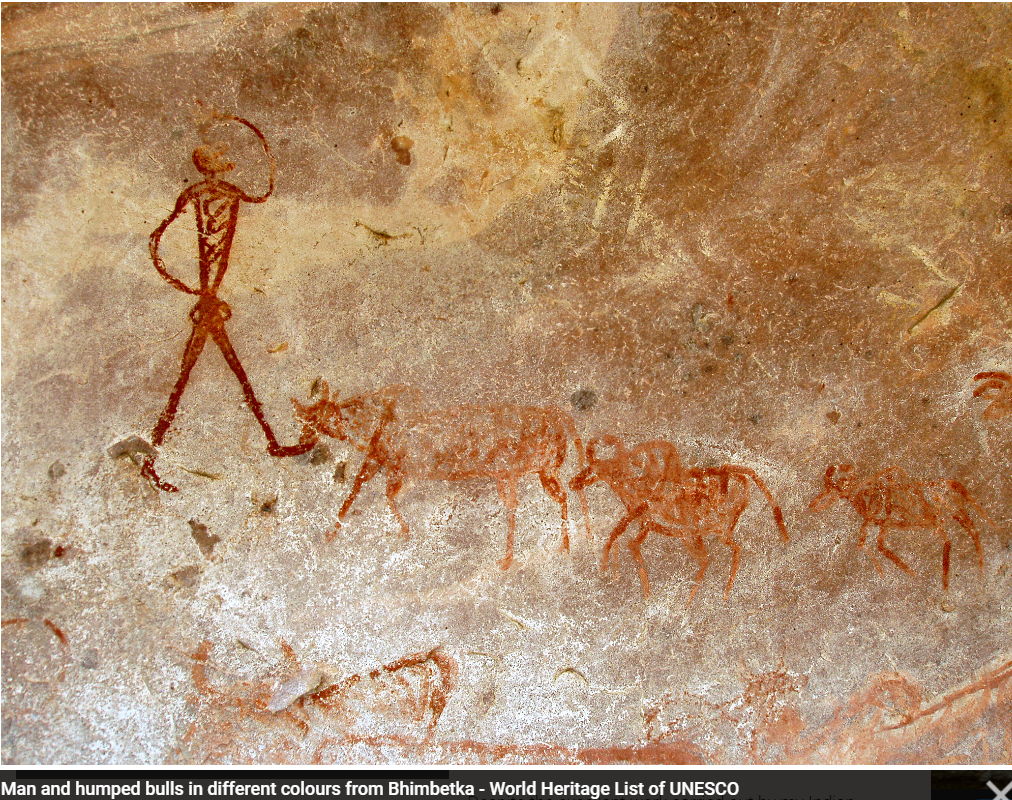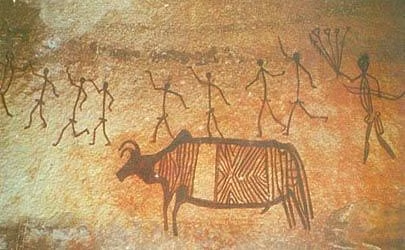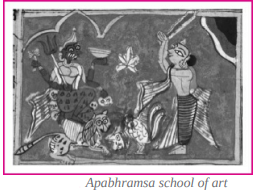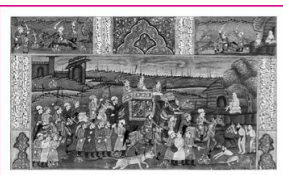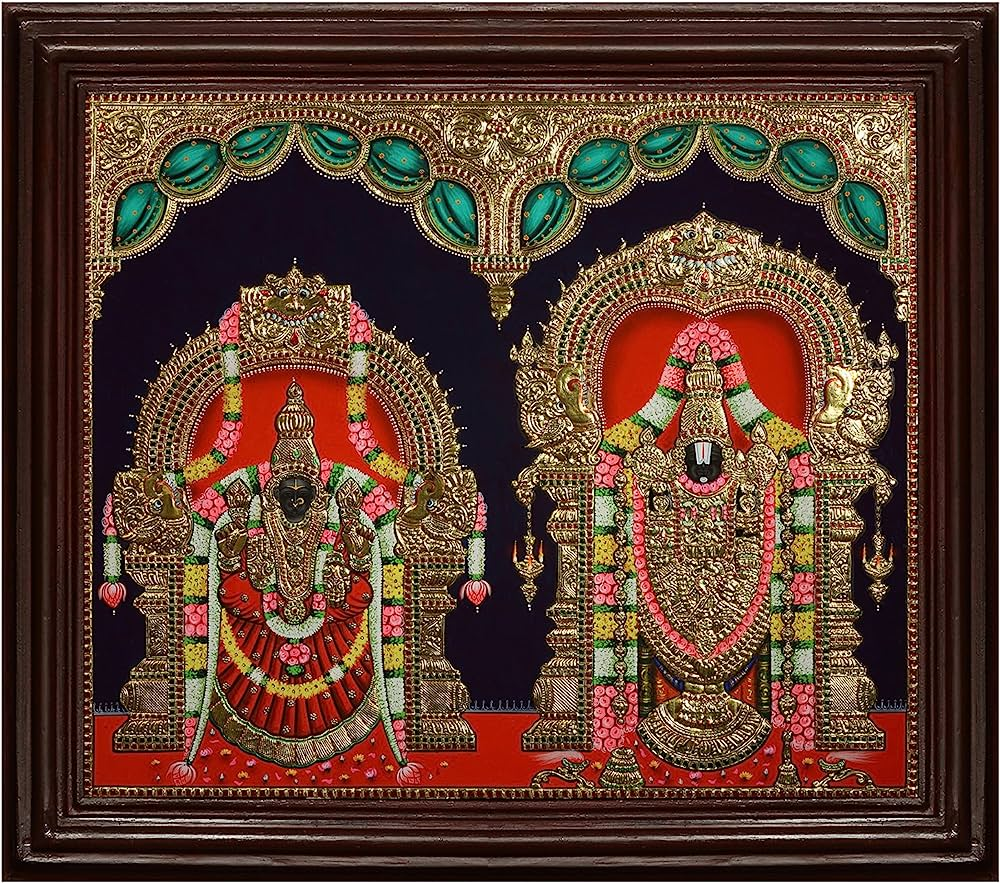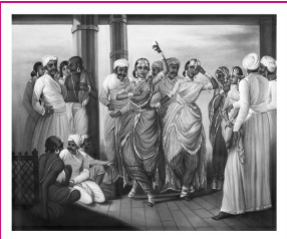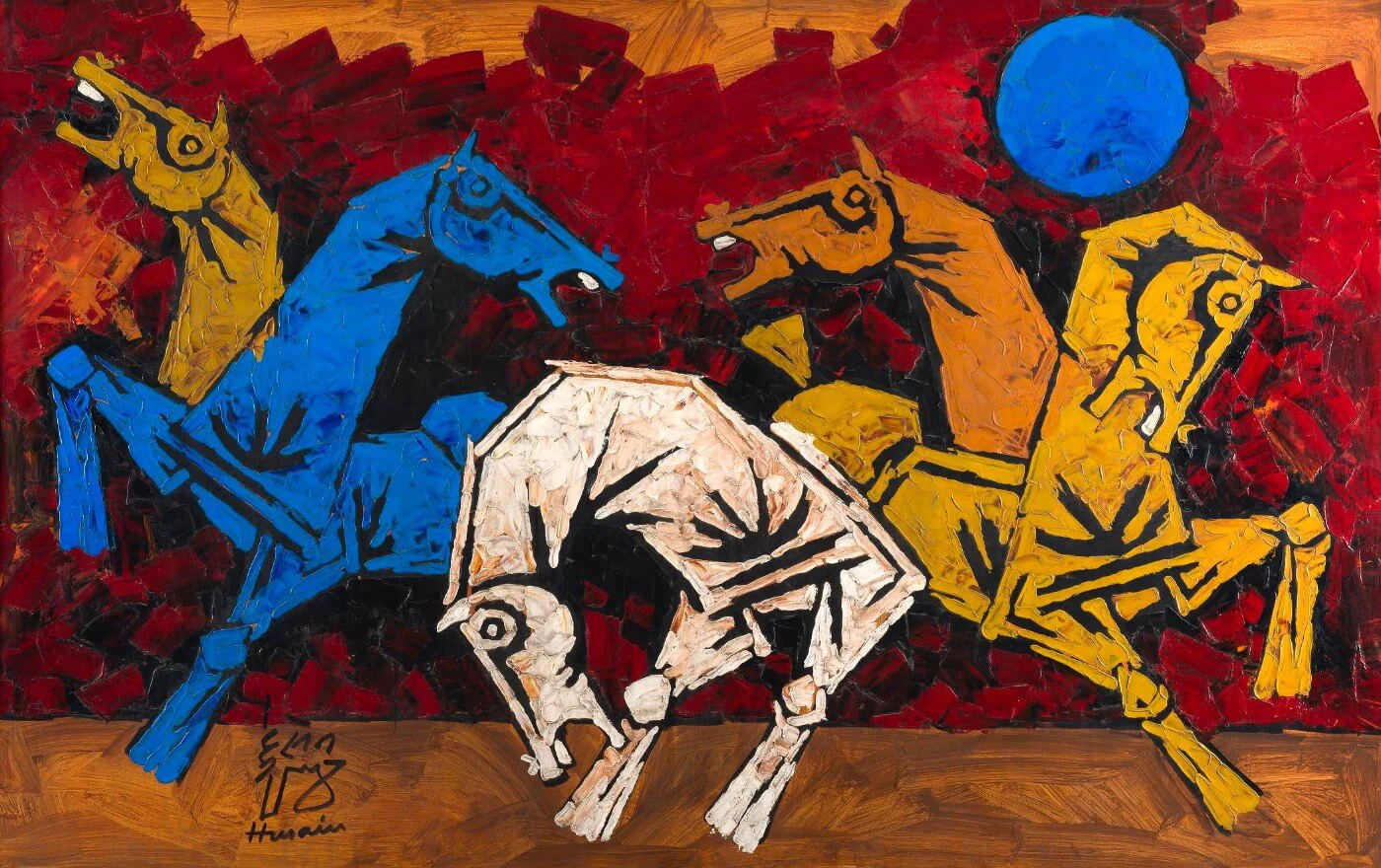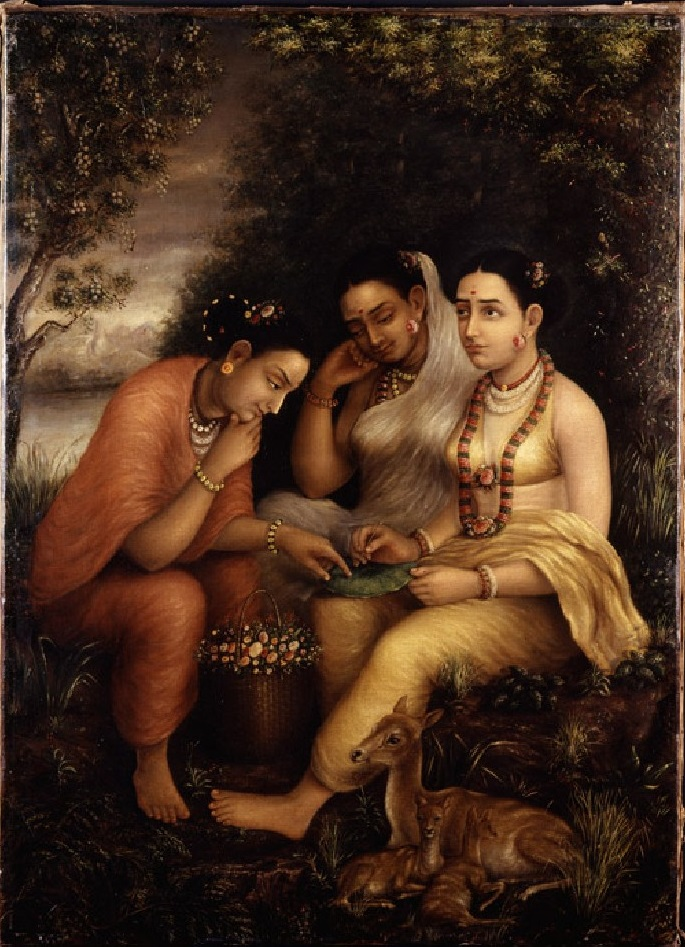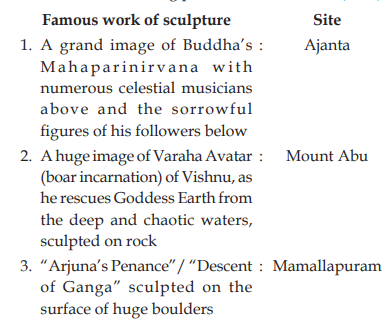Indian Heritage & Culture
Indian Painting (Part-I)
- 08 Nov 2023
- 32 min read
For Prelims: Indian Painting, Mughal and Rajput style, Principles of Painting, Rock paintings of Bhimbetaka, Painted pottery of the Indus Valley Civilisation, Rupabheda, Sadrisyan, Bhava, Varnikabhanga, Pramanam, Lavanyayoganam, Lepya Chitra, Pre-Historic Painting, Petroglyphs, Zoo Rock Shelter, Mural paintings, Ajanta Cave Paintings, Ellora Cave Paintings, Armamalai Cave Paintings, Jogimara Cave Paintings, Miniature Paintings, Pala School of Art, Apabhramsa School of Art, Miniature Art during Delhi Sultanate, Nimatnama, Mughal Era Miniature Painting, technique of foreshortening, Tasvir Khana, Tutinama (Tale of a Parrot), calligraphy, Rajasthani Schools of Painting, Mewar School of Painting, Sahibdin, ‘tamasha’ paintings, Kishangarh School of Painting, Bani Thani, Pahari Styles of Painting, Jammu or Dogra School, Kangra School, Basholi School, Ragamala Paintings, Miniatures in South India, Tanjore Paintings, Mysore Paintings, gesso paste’, Modern Paintings, Company Paintings, Bazaar Paintings, Raja Ravi Verma, Raphael of the East, Rang Rasiya, Bengal School of Art, Abhanindranath Tagore, Bharat Mata, Rabindranath Tagore, Cubist Style of Painting, M.F Hussain, Personification of Romance,Progressive Artists Group.
For Mains: Evolution of Painting in India, Need to conservation of pre-historic paintings, paintings as a historical records of the past time, fusion of Indian Philosophy with Painting.
Context
India has a long-standing tradition of artistic excellence, with painting emerging as a prominent medium for its expression, flourishing in the country since ancient times.
The history of painting can be traced through the ancient and medieval periods where books were illustrated with paintings. The miniature style dominated the Mughal and Rajput courts. With the coming of the Europeans, the art of painting and engraving took a Western turn.
The history of paintings can be known from primitive rock paintings of Bhimbetaka, Mirzapur and Panchmarhi. They were followed by the painted pottery of the Indus Valley Civilisation, but the real beginning of the art of painting began from the Gupta Age.
What are the Principles of Painting?
- In the 3rd century AD, Vatsyayana in his book Kamasutra mentioned six main principles/limbs or shadanga of paintings. They are:
- Variety of form - Rupabheda
- The portrayal of likeliness of the subject - Sadrisyan
- Creation of luster and gleam with the colours - Bhava
- Mixing of colours to resemble the effects of modelling - Varnikabhanga
- Proportion of the object or subject - Pramanam
- Immersion of emotions - Lavanyayoganam
- There are numerous references to the art of painting in Brahmanical and Buddhist literature, for example, the representation of the myths and lore on textiles is known as Lepya Chitra.
- The play, Mudrarakshasa by Vishakhadutta, also mentions the names of various paintings or patas, which are important to understand the different styles of paintings and to observe all the principles of paintings.
What are Pre-Historic Painting?
- About:
- The pre-historic paintings were generally executed on rocks and these rock engravings were called Petroglyphs. The first set of prehistoric paintings was discovered in Bhimbetaka caves in Madhya Pradesh in 1957-58.
- These paintings have been called the ‘Zoo Rock Shelter’ because they depict an elephant, rhinoceros, cattle, snake, spotted deer, barasingha, etc.
- Three Major Phases:
- Upper Paleolithic Period (40000–10000 BC): The walls of the rock shelter caves were made of quartzite and so they used minerals for pigments.
- The most common mineral was ochre or geru mixed with lime and water.
- Mesolithic Period (10000–4000 BC): This period mainly saw the use of red colour. In comparison to the Upper Paleolithic period, the size of the paintings also became smaller during this period.
- Chalcolithic Period (3500 BC-1000 BC): This period saw an increase in the number of paintings using the green and yellow colours.
- Most of the paintings concentrate on depicting battle scenes.
- Some of the paintings from the Chalcolithic period can be seen in the Jogimara caves in the Ramgarh hills in Surguja district of Chhattisgarh. These are dated to be painted around 1000 BCE.
What are Bhimbetka Rock Paintings?
- About:
- It is located south of Bhopal in the Vidhyan ranges of Madhya Pradesh. The rock shelters have more than 500 rock paintings. It was declared a UNESCO World Heritage Site in 2003.
- The oldest paintings are estimated to be 30,000 years old and have survived due to their location deep inside the caves.
- There is marked continuity in occupancy of the caves from 100,000 BC to 1000 AD with many paintings being painted on top of one another.
- The paintings at Bhimbetka belong to Upper Paleolithic, Mesolithic, Chalcolithic, early historic and medieval period. However, most of the paintings belong to the Mesolithic age.
- Romanticisation of Daily Chores: The paintings generally portray the everyday life of pre-historic men often in stick-like human figures. Various animals like elephants, bison, deer, peacock and snake are depicted.
- Domination of Hunting Scene: The paintings also show hunting scenes and war scenes with men carrying weapons like bows, arrows, spears, shields and swords.
- Use of Geometric Symbols: Some paintings also have simple geometric designs and symbols. The other themes of the paintings are dancing, playing music, animal fighting, honey collection, etc.
- Depiction of Social life: Social life is well-depicted with the presence of children playing, women making food, community dancing, etc.
- It is located south of Bhopal in the Vidhyan ranges of Madhya Pradesh. The rock shelters have more than 500 rock paintings. It was declared a UNESCO World Heritage Site in 2003.
What are the Classification of Indian Paintings?
Mural Paintings in India
- The works on the walls or a solid structure are referred to as Murals. These have existed in India since ancient times and can be dated between the 10th century BC and the 10th century AD.
- The Mural paintings are unique because of their sheer size. They cannot be contained on paper and need to be executed on the walls of large structures, usually caves and temple walls.
- In the ancient period, these were utilised by three major religions: Buddhism, Jainism and Hinduism. Some of the best examples of mural paintings are:
- Ajanta Cave Paintings:
- Ajanta caves were carved in the 4th century AD out of volcanic rocks. It consists of a set of 30 caves, carved in a horse-shoe shape. These caves are quite popular for their exquisite mural paintings that took around four to five centuries to complete under the reign of the Mauryan Empire.
- Murals in cave no. 9 and 10 belong to the Sunga period, while the rest belong to the Gupta period. The walls of the caves have both murals and fresco paintings (painted on wet plaster). They use tempera style, i.e. use of pigments.
- The common themes of these paintings range from Jataka stories to life of Buddha to elaborate decorative patterns of flora and fauna.
- Ellora Cave Paintings:
- The mural paintings in the Ellora caves are found in five caves, mostly limited to the Kailasa temple. These murals were done in two phases.
- The first phase paintings were done during the carving of the caves, while the second phase ones were done several centuries later.
- The earlier paintings show Vishnu with his consort Lakshmi borne through the clouds by Garuda, the celestial bird. The later paintings, made in Gujarati style, depict the procession of Shaiva holy men.
- The mural paintings in the Ellora caves are found in five caves, mostly limited to the Kailasa temple. These murals were done in two phases.
- Armamalai Cave Paintings:
- Armamalai Cave Paintings are situated in the Vellore district of Tamil Nadu, these natural caves were converted into a Jain temple in the 8th century. Unbaked mud structures are located within the cave, which acts like a place of rest for Jain saints.
- The beautiful colourful paintings on the walls and roof depict the tales of Astathik Palakas (deities protecting eight corners) and Jainism.
- Jogimara Cave Paintings:
- Jogimara Cave Paintings is an artificially carved-out cave located in the Surguja district of Chattisgarh. It is dated back around 1000-300 BC and has a few paintings and inscriptions of a love story in Brahmi script.
- The cave is said to be an attachment to the amphitheatre and paintings were made to decorate the room.
- Ajanta Cave Paintings:
Miniature Paintings
- About:
- The word ‘miniature’ is derived from the Latin word ‘Minium’, which means red lead paint. This painting was used in illuminated manuscripts during the Renaissance period.
- It is generally confused with the word minimum, which would mean that they were small in size. The Indian subcontinent has long traditions of these miniature paintings and many schools developed that have differences in composition and perspective. Miniatures are small and detailed paintings.
- The painting should not be larger than 25 square inches. The subject of the painting should be painted in not more than 1/6th of the actual size.
- They usually have bulging eyes, pointed nose and slim waist.
- Early Miniature: Early miniature paintings were initially less refined, featuring minimal decoration. Over time, they evolved to include more detailed embellishments, ultimately becoming similar to today's miniature paintings—representing simply the early phase of this art form.
- They were often painted for either books or albums, on perishable material including paper, palm leaves and cloth. These paintings developed between the 8th and 12th centuries and can be attributed to the eastern and western regions. Two prominent schools of early miniature paintings are:
- Pala School of Art: This school was flourishing during 750-1150 AD. These paintings are generally found as a part of Buddhist manuscripts and were generally executed on palm leaf or vellum paper.
- These paintings are characterised by sinuous lines and subdued tones of the background imagery. There are lonely single figures in the paintings and one rarely finds group paintings.
- The proponents of the Vajrayana school of Buddhism also used and patronised these paintings.
- Apabhramsa School of Art: This school traces its origin to Gujarat and Mewar region in Rajasthan. It was the predominant school of painting in western India during 11th to 15th century.
- Transition Period Miniature: The coming of the Muslims on the Indian subcontinent was a sign of change and brought forth a cultural renaissance in the 14th century.

- Miniature Art During Delhi Sultanate: These paintings tried to bring together the Persian elements of their origins with the Indian traditional elements.
- Mughal Era Miniature Painting: The paintings made in the Mughal period had a distinctive style as they were drawn from Persian antecedents.
- There was a change in colour palette, themes and forms. The focus shifted from depicting the god to glorifying the ruler and showing his life.
- They focused on hunting scenes, historical events and other court related paintings.
- The painters were supposed to concentrate on ensuring the accuracy of line drawings. Except for religious paintings, the Mughals were known for their diverse themes.
- They brought the technique of foreshortening to the Indian painter’s repertoire. Under this technique, “objects were drawn in a way that they look closer and smaller than they really are.”
- The styles of paintings under the successive rulers are as follows:
| Mughal Emperor | Contribution to Painting | Notable Artistic Achievements |
| Babur | Patronized Persian artist Bihzad for Mughal family tree illustrations. | Limited direct involvement due to a short reign. |
| Humayun | Great patron of the arts, introduced Persian influence to Mughal paintings and created illustrated albums. | Promoted Persian artistic styles and influenced Mughal painting. |
| Akbar | Established Tasvir Khana, a formal artistic studio with salaried artists. Created the illustrated manuscript "Tutinama." Encouraged calligraphy in paintings. | Prominent manuscripts: Tutinama (Tale of a Parrot), Hamzanama, Anvar-i-Suhaili, and Gulistan of Sadi. |
| Jahangir | Reached the zenith of Mughal painting. Preferred naturalistic themes like flora and fauna (birds, animals, trees, flowers). Introduced the trend of decorated margins around paintings. | Jahangir was a skilled artist himself. Known for naturalistic paintings of the Zebra, turkey, and the cock. |
| Shah Jahan | Attempted to reduce liveliness and introduce stillness, influenced by European art. Encouraged the use of pencils for sketching. Increased the use of gold and silver in paintings and preferred brighter color palettes. | Artistic style marked by European influence and a shift towards stillness and opulence. |
| Aurangzeb | Did not encourage painting, leading to the migration of Mughal court painters to provincial courts in regions like Rajasthan. | Contributed to the decline of Mughal painting during his reign. |
- Regional Schools of Art: Regional Schools of Art remembered their Indian roots and a penchant for colourful paintings as opposed to the more naturalistic Mughal style. The different schools and styles that developed in this period were:
- Rajasthani Schools of Painting: It is more or less synonymous to the Rajput school of paintings. There are several sub- genres of Rajasthani paintings which correspond to their princely state of origin.
- Mewar School of Painting: Mewar painting is dominated by the extraordinary figure of Sahibdin. This period of Mewari painting focuses on Sahibdin’s depiction of literary texts – the Rasikapriya, the Ramayana and the Bhagavata Purana.
- The unique point of this period is the extraordinary ‘tamasha’ paintings that show court ceremonial and city views in unprecedented detail.
- Kishangarh School of Painting: Paintings at Kishangarh is associated with the most romantic legends – Sawant Singh and his beloved Bani Thani, and of the intertwining of lives and myths, romance and bhakti. It is sometimes argued that the women in ‘bani thani’ is said to resemble the character of Radha.
- Mewar School of Painting: Mewar painting is dominated by the extraordinary figure of Sahibdin. This period of Mewari painting focuses on Sahibdin’s depiction of literary texts – the Rasikapriya, the Ramayana and the Bhagavata Purana.
- Pahari Styles of Painting: This style of painting developed in the sub-himalayan states that were also under the umbrella of Mughal over lordship. Hence, the Pahari paintings can be grouped into two groups:
- Jammu or Dogra School: Northern Series
- Basholi and Kangra School: Southern Series
- A typical Pahari painting would bring several figures into the canvas. Each figure is different in composition, colour and pigmentation.
- Basholi School: This was the early phase and expressive faces with a receding hairline and big eyes that are shaped like lotus petals characterise it. These paintings use a lot of primary colours, i.e. red, yellow and green. They used the Mughal technique of painting on clothing but developed their own styles and techniques.
- Kangra School: These paintings were marked with a sensuality and intelligence that the other schools lacked. The very famous group of paintings is the ‘Twelve Months’ where the artist tried to bring forth the effect of the twelve months on the emotions of human beings.
- Rajasthani Schools of Painting: It is more or less synonymous to the Rajput school of paintings. There are several sub- genres of Rajasthani paintings which correspond to their princely state of origin.
Is there a Common Painting Style Shared among Most Schools of Indian Painting?
- Ragamala Paintings: Ragamala Paintings are a series of illustrative paintings from medieval India based on Ragamala or the ‘Garland of Ragas’, depicting various Indian musical Ragas. They stand as a classical example of the amalgamation of art, poetry and classical music in medieval India.
- Ragamala paintings were created in most Indian schools of painting, starting in the 16th and 17th centuries and are today named accordingly, as Pahari Ragamala, Rajasthan or Rajput Ragamala, Deccan Ragamala, and Mughal Ragamala.
- In these painting, each raga is personified by a colour describing the story of a hero and heroine (nayaka and nayika) in a particular mood. it also elucidates the season and the time of day and night in which a particular raga is to be sung.
- Moreover, many paintings also demarcate the specific Hindu deities attached with the raga, like Bhairava or Bhairavi to Shiva, Sri to Devi etc. The six principal ragas present in the Ragamala are Bhairava, Deepak, Sri, Malkaush, Megha and Hindola.
Miniatures in South India
The trend of making miniature paintings in the South Indian states is different from the north Indian schools owing to the heavy use of gold in these paintings. Furthermore, they concentrated on painting divine creatures much more than painting the rulers who patronized them. Some of the major schools are:
- Tanjore Paintings: The Thanjavur or Tanjore School is famous for the special style of decorative paintings. The Maratha rulers patronized them during the 18th century.
- These paintings are unique as they are mostly created on glass and board instead of cloth and vellum preferred in north India. Use of brilliant colour patterns and the liberal use of gold leaf are uniqueness of these paintings.
- They used many types of gemstones and cut glasses for embellishments to create larger than life images.
- These paintings reached their zenith under the patronage of Sarfoji Maharaj who was a great patron of arts.
- Mysore Paintings: These paintings were patronised by the rulers of the Mysore province and continued in the British period too.
- The major theme of the Mysore paintings is the depiction of Hindu gods and goddesses. The unique part of these paintings is that they had two or more figures in each painting and one figure predominates all the others in size and colour.
- These paintings use the technique of the ‘gesso paste’, which is a mixture of zinc oxide and Arabic gum. This gives a particular base to the painting that develops sheen on the background.
- They counter it with the use of muted colours that are not so bright so as to counteract the background.
Modern Paintings
- Company Paintings: In the colonial period, a hybrid style of painting emerged that combined the elements of Rajput, Mughal and other Indian styles of painting with European elements (styles and techniques).
- These paintings evolved when the British Company officers employed painters who had been trained in Indian styles. Hence, they mixed their employers European tastes with their Indian training. This was called the ‘Company Paintings’.
- They were distinguished by the use of water colour and in technique by the appearance of linear perspective and shading.
- Lord Impey and Marquess Wellesley patronised the painters; several painters were engaged in painting the ‘exotic’ flora and fauna of India.
- Bazaar Paintings: This school was also influenced by the European encounter in India. They were different from the Company paintings as that school mixed European techniques and themes with Indian ones.
- The Bazaar school did not take any Indian influence but took the Roman and Greek influence. They made the painters to copy the Greek and Roman statues.
- This school was prevalent in the Bengal and Bihar region. A part from the Greco-roman heritage, they made paintings on everyday bazaar that showed Indian bazaars with European background.
- One of the most famous genres was of depicting Indian courtesans dancing before the British officials. They also painted religious themes but the figures of Indian Gods and Goddesses with more than two axes and elephant faces like that of Lord Ganesha were prohibited as they deviated from the European notion of natural human figurine.
- Bengal School of Art: The Bengal school is supposed to have a reactionary approach to the existing styles of paintings in the 1940s –1960s. This school is unique as they use simple colours.
- The idea of the Bengal school came up with the works of Abhanindranath Tagore in the early 20th century. He tried to incorporate Swadeshi values in Indian art and tried to reduce the influence of Western art style among artists.
- He is known for his painting Bharat Mata and various Mughal-themed paintings.
- The other notable painter of this school is Nandlal Bose. He was also entrusted with the task of illuminating the original document of the Constitution of India.
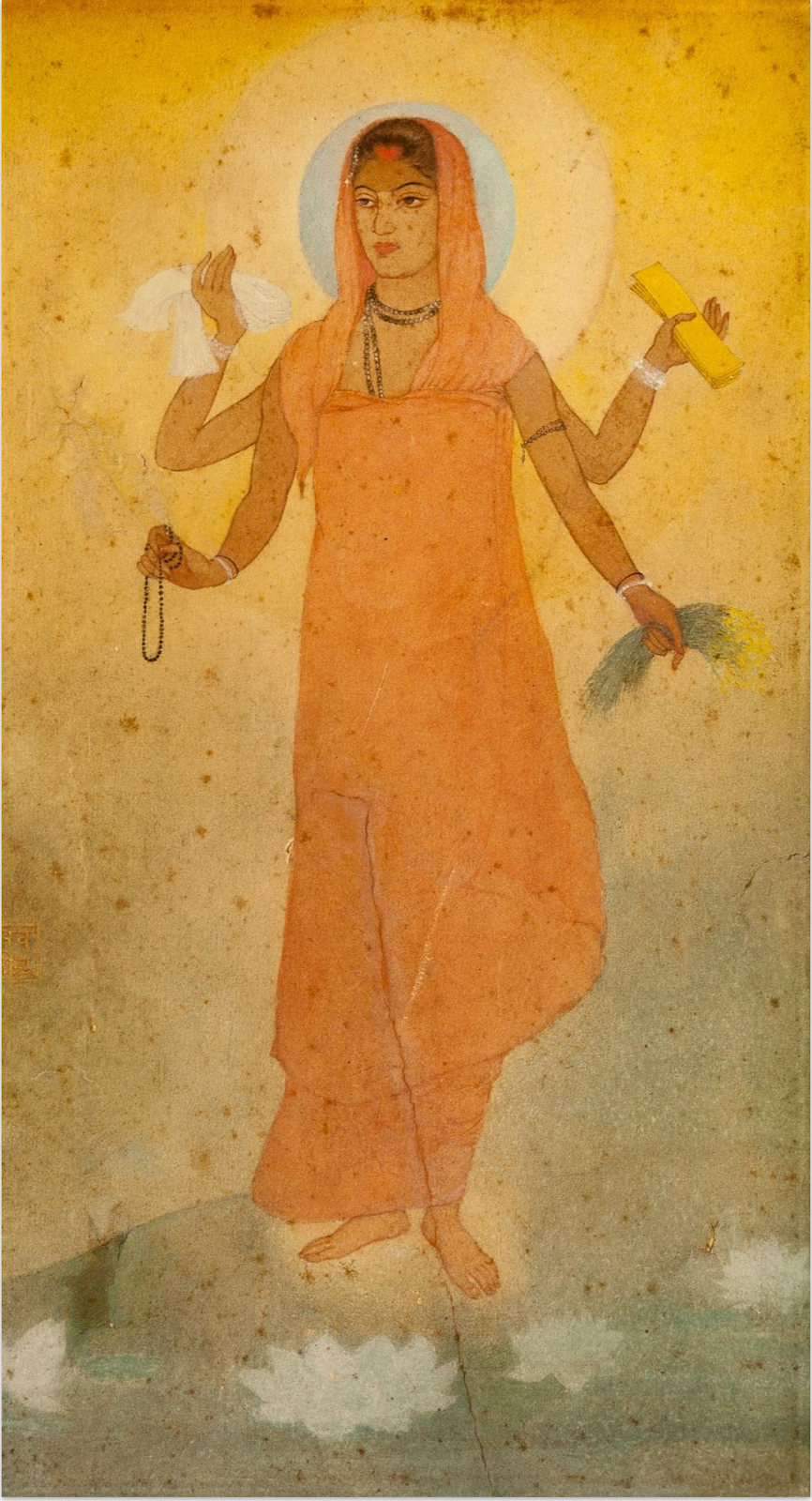
- Rabindranath Tagore was associated with this school. His paintings are unique as they used dominant black lines that made the subject look very prominent. He made small-sized paintings.
- Cubist Style of Painting: The cubist movement of Painting took its inspiration from the European Cubist movement.
- Under this style, the objects were broken, analysed and then reassembled. The artist reconstructed this process on the canvas through the use of abstract art forms.
- They tried to achieve the perfect balance between line and colour.
- One of the most popular cubist artists in India was M.F Hussain, who made a series of paintings called the ‘Personification of Romance’.
- Progressive Artists Group: They use progressive and bold themes. They amalgamated these themes with softer and more abstract themes.
- They lacked any uniformity among themselves but were inspired by European Modernism. The founder of this group was Francis Newton Souza but the more famous members were S.H Raza, H. A Gade, Ara etc.
- Even the famous cubist painter M.F Hussain was a member of the Progressive Artist Group.
Who was Raja Ravi Verma?
- He is considered to be the originator of the school of modern painting. The school was called ‘modern’ because of the heavy influence of Western techniques and themes.
- He was unique as he brought together elements of South Indian painting with the Western techniques of colour and style. He belonged to the state of Kerala and was dubbed as the ‘Raphael of the East’ because of his brilliant brush strokes and almost lifelike paintings.
- Some of his very famous works include Lady in the Moonlight, Mother India, etc. He gained nationwide recognition for his paintings from the epic Ramayana, especially the one titled ‘Ravana Kidnapping Sita’.
- A film has been made recently on him named “Rang Rasiya”.
Mural Art: Murals - To The Point | Drishti IAS English
\Art & Culture - Paintings in India (Part - I)
Art & Culture - Paintings in India (Part - II)
UPSC Previous Years Questions
Prelims
Q. The painting of Bodhisattva Padmapani is one of the most famous and oft-illustrated paintings at (2017)
(a) Ajanta
(b) Badami
(c) Bagh
(d) Ellora
Ans: (a)
Q. With reference to the Indian history of art and culture, consider the following pairs (2014)
Which of the pairs given above is/are correctly matched?
(a) 1 and 2 only
(b) 3 only
(c) 1 and 3 only
(d) 1, 2 and 3
Ans: C
Q. Consider the following historical places: (2013)
- Ajanta Caves
- Lepakshi Temple
- Sanchi Stupa
Which of the above places is/are also known for mural paintings?
(a) 1 only
(b) 1 and 2 only
(c) 1, 2 and 3
(d) None
Ans: (b)
Q. There are only two known examples of cave paintings of the Gupta period in ancient India. One of these is paintings of Ajanta caves. Where is the other surviving example of Gupta paintings? (2010)
(a) Bagh caves
(b) Ellora caves
(c) Lomas Rishi cave
(d) Nasik caves
Ans: (b)
Q. The well-known painting “Bani Thani” belongs to the (2018)
(a) Bundi school
(b) Jaipur school
(c) Kangra school
(d) Kishangarh school
Ans: (d)
Q. Kalamkari painting refers to (2015)
(a) a hand-painted cotton textile in South India
(b) a handmade drawing on bamboo handicrafts in North-East India
(c) a block-painted woollen cloth in Western Himalayan region of India
(d) a hand-painted decorative silk cloth in NorthWestern India
Ans: (a)
Q. Consider the following famous names: (2009)
- Amrita Sher-Gil
- Bikash Bhattacharjee
- N.S. Bendre
- Subodh Gupta
Who of the above is/are well known as artist(s)?
(a) 1 only
(b) 1 and 4 only
(c) 2, 3 and 4 only
(d) 1, 2, 3 and 4
Ans: (d)
Mains
Q. Mesolithic rock-cut architecture of India not only reflects the cultural life of the times but also a fine aesthetic sense comparable to modern painting. Critically evaluate this comment. (2015)
Q. Safeguarding the Indian art heritage is the need of the moment. Discuss. (2018)
Q. The “flute playing Krishna” theme is very popular in Indian art. Discuss. (2012)



